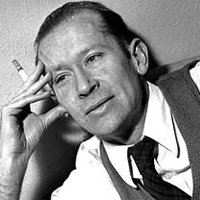in Just-spring by Edward Estlin Cummings: Summary and Critical Analysis
The poem 'in Just-spring' by Cummings is about the spring as seen from the viewpoint of the child. The very title is said with an excitement of remembering childhood, and the power to enjoy the spring. Two boys Eddie and Bill come running from their marble and pirate games.

E. E. Cummings (1894-1962)
The speaker himself is so delighted at the thought of such a spring world that he simply repeats: “it’s/ spring/ when the world is puddle-wonderful” with conspicuous emphases on each word and on the fore grounded new compound “puddle-wonderful”. The puddle (pool of dirty water on the road) is a wonderful thing to the child. The ‘queer’ old balloon man whistles far and wee. This man is a symbol of adulthood, puberty and sexuality, and the imperfect and ugly age that the children do not yet know anything about. This man, as indicated later on in the poem, is Pan, the goat-footed Greek god.
Pan is a lecherous and ugly old man who is despised by the girls; but though he is disliked, he is essential because it is he who brings about the sexual changes in the growing children. This god is cast in the form of the modern balloon man. The sheer joy of the children is significant in the light of the fact that the balloon man is bringing an end to their childhood. But this, as the poem implies, is a positive thing, for every part of life, as it comes naturally, is desirable. In fact, the spring is not a static season; it is a process that leads naturally to summer, growth, fertility, and even age & death at length.
The poem “in Just” begins with the speaker joyfully describing the world as “mud luscious”. Some words are elongated across the page; others are jammed together. The words come excitedly without punctuation. The elongated “wee”, while denoting the “we” is an unabashed squeal of delight. Racing over from his imaginary games, the speaker is clearly a child. The description of puddles as “wonderful” mirrors a child’s perspective. This god played music for the dancing nymphs but was rejected because of his ugly appearance: cleft foot and deformed and ageing body; and besides he was a lecher. Though the simple theme of childhood is apparent and it almost obscures any other meaning in the poem, the poem may also be read as a displacement and an adaptation of the creation in Genesis. The ugly old man appears against a context of childhood bliss; but here the fall is not taken as anything tragic. The classical analogue of the modern balloon man is pan; he is not only the Christian conception of the devil, but also the Good shepherded who oversees the wee-being of his flock and encourages their propagation. By awakening in the children the impulses or instincts of sexuality, the balloon man, in effect, creates new beings, and imparts the consequences of evil, goodness and variations or interactions thereof. The poem is in three movements, each built about the refrain of the balloon man’s whistle.
There is binary opposition between the happy children and the old man who has experienced the tragic and painful parts of life. But the children don’t understand that this goat-footed man is the symbol of tragedy contrasting the picture of the children with the picture of a tragic old man. There is the speed in the lines as we talk about the children. But as soon as he talks about old man the tempo slows down. The approach of spring resembles the life and activity of the children. The meaning is conveyed through wordplay, visual impression of typography, the link between the sound symbolism, imagery (child, puddle, and piracies), and use of compound words. The fast friends are brought together by the typography, and that also shows their sharing of feelings; it is as though they are united.
Cite this Page!
Sharma, K.N. "in Just-spring by Edward Estlin Cummings: Summary and Critical Analysis." BachelorandMaster, 9 Nov. 2013, bachelorandmaster.com/britishandamericanpoetry/in-just.html.
